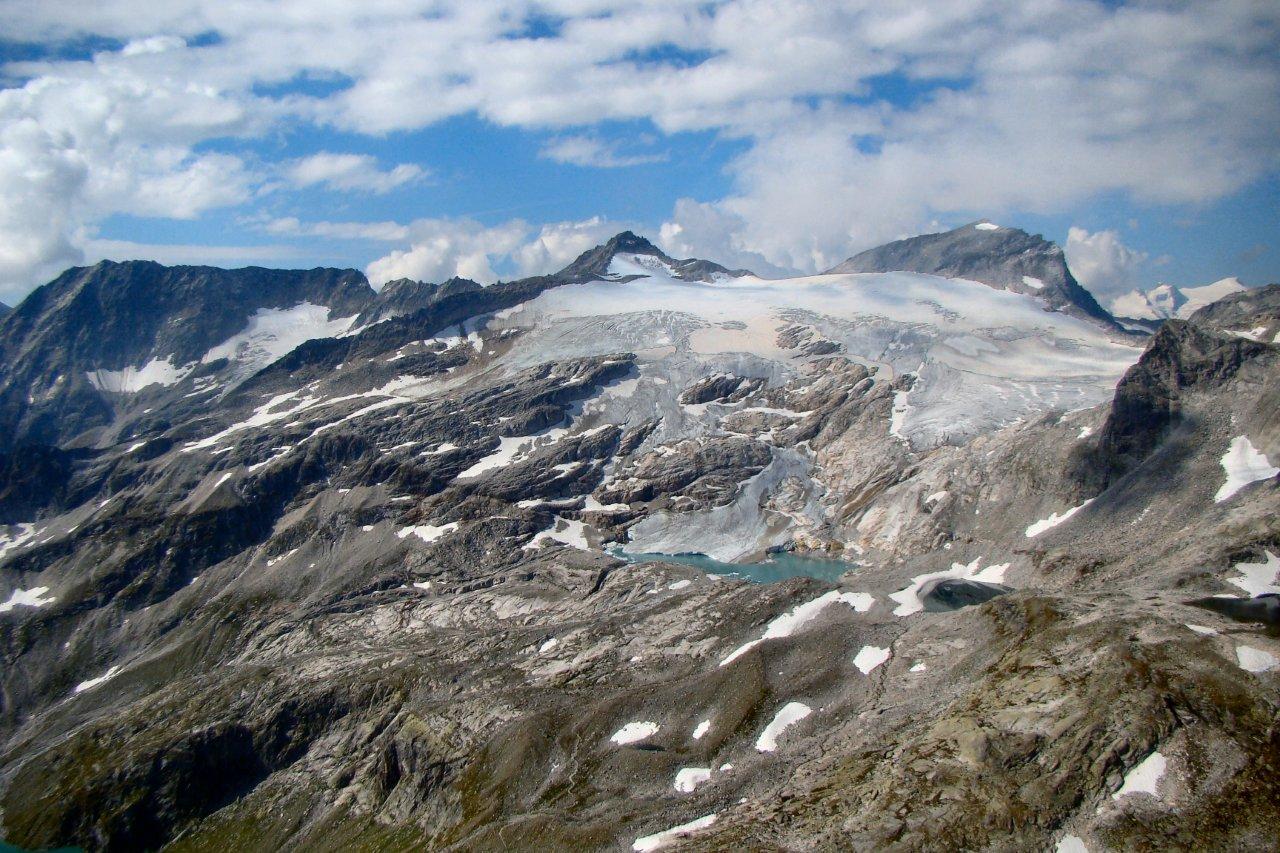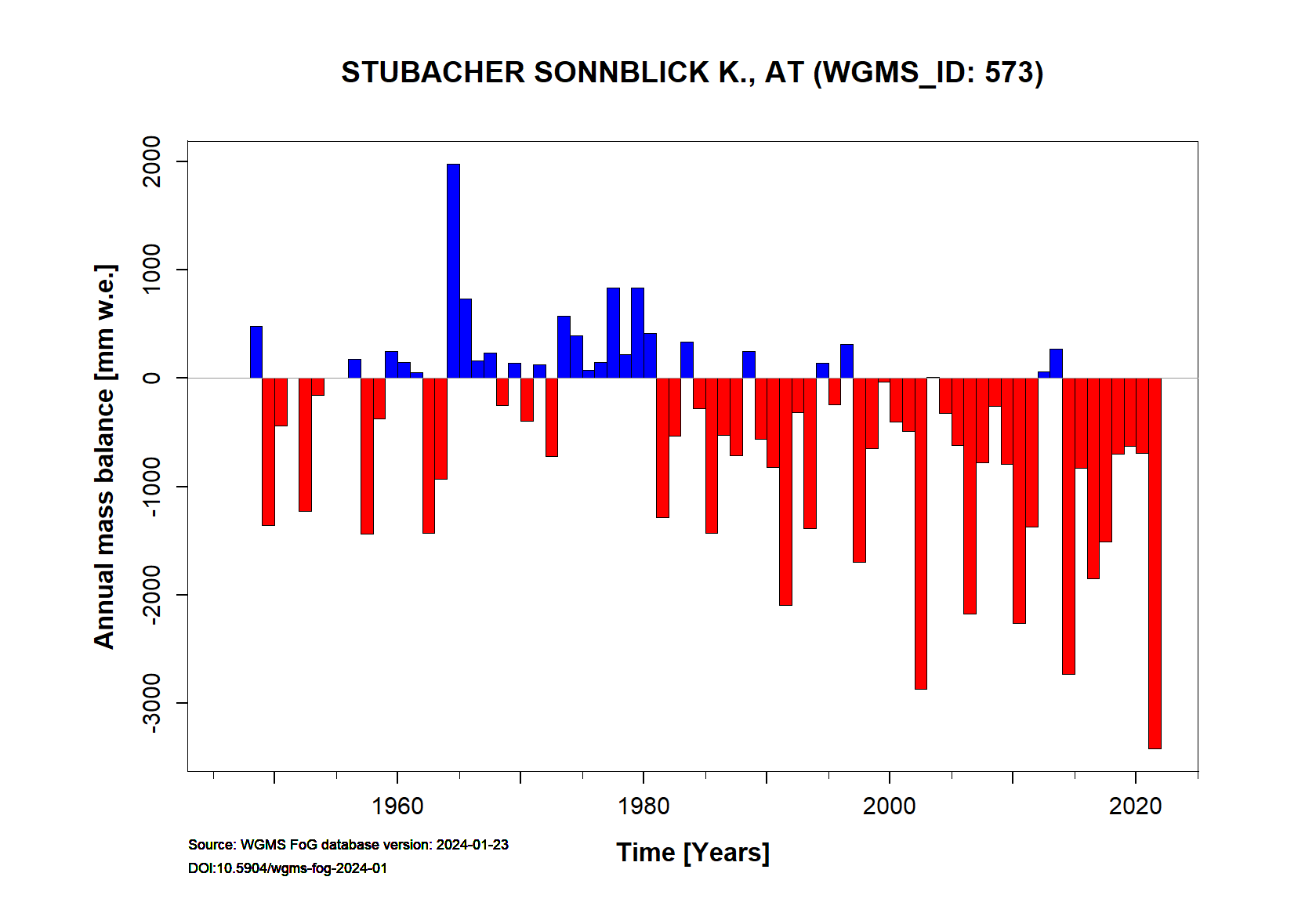Mass Balance Factsheet for the Stubacher Sonnblickkees, Alps
Stubacher Sonnblickkees (SSK) is situated in the Hohe Tauern Range (Eastern Alps, directly at the main Alpine ridge) in the LTER Site Oberes Stubachtal in the south of Salzburg Province, Austria. SSK can be classified as a slope glacier, faces east, starting at elevations close to 3050 m and terminating at 2650 m a.s.l. In 2023, SSK covers an area of less than 0,8 km² compared with 1.7 km² in 1980. The relief is covered by a relatively thin ice cover and there is no regular glacier tongue. We expect a separation into three parts in the next years.
The main reason for selecting this glacier for mass balance observations was to verify on a complex glacier how the mass balance methods and the conclusions – derived during the pioneer phase of glaciological investigations in the 1950s and 1960s – could be applied to the SSK glacier. Annual direct mass balance measurements were started in 1963. In 1965 the project was incorporated into the Austrian glacier measurement sites within the International Hydrological Decade (IHD) 1965 – 1974 (Slupetzky, 1974, 1975) and was afterwards extended via the International Hydrological Program (IHP) 1975 – 1981 (Slupetzky, 1989). During both periods, the main financial support came from the Hydrological Survey of Austria. After 1981 funds were provided by the Hydrological Service of the Federal Government of Salzburg. The research was conducted from 1965 until 2015 by Heinz Slupetzky (Slupetzky et al. 2014) from the (former) Department of Geography of the University of Salzburg. From 1964 to 1981, the annual mass balance was calculated by direct measurements. Based on these records of 17 years, a regression analysis between the specific net mass balance and the ratio of ablation area to total area (AAR) has been used since then (Slupetzky, 2015). The basic requirement was mapping the maximum snow depletion at the end of each balance year. There was the advantage of Heinz Slupetzky’s detailed local and long-term experience, which ensured homogeneity of the series on individual influences of the mass balance calculations. Verifications took place as often as possible by means of independent geodetic methods, i.e. monoplotting , aerial and terrestrial photogrammetry, more recently also laser scans. The semi-direct mass balance determinations used at SSK were tentatively compared with data from periods of mass/volume change, resulting in promising first results on the reliability of the method. In recent years re-analyses of the mass balance series have been conducted by the World Glacier Monitoring Service and will be done at SSK, too. The methods developed at SSK also add to another objective, much discussed in the 1960s within the community, namely, to achieve time- and labour-saving methods to ensure continuation of long-term mass balance series. The regression relations were used to extrapolate the mass balance series back to 1959, the maximum depletion could be reconstructed by means of photographs for those years. R. Günther (1982) calculated the mass balance series of SSK back to 1950 by analysing the correlation between meteorological data and the mass balance; he found a high statistical relation between measured and determined mass balance figures for SSK (Zagel et al. 2017).
Length variations have been measured since 1960 within the OeAV glacier length measurement programme. Between 1965 and 1981, there was a mass gain of 10 million cubic metres. With a time lag of 10 years, this resulted in an advance until the mid-1980s. Since 1982 there has been a distinct mass loss of 45 million cubic metres by 2013. In recent years, the glacier has disintegrated faster, forced by the formation of a progglacial lake at the glacier terminus and by the outcrops of rocks (typical for the slope glacier type), which have accelerated the meltdown. The formation of this lake is well documented. The glacier has retreated by some 650 m since 1981.
The mass balance record of SSK was the first one established in the Hohe Tauern region and is one of the longest measurement series worldwide. Today, the Department of Geoinformatics at the University of Salzburg, with support of the Hydrographical Survey of the Federal Government of Salzburg continue the series (Zagel et al. 2023), until the glacier is completely gone, which seems to be realistic in the next 20-30 years because of the ongoing global warming.
For additional information on the status of the glacier and on data relating to annual mass balance and other measurements, visit the WGMS Fluctuations of Glaciers Browser.
FACTS:
- Political unit: AT
- WGMS ID: 573
- Latitude: 47.13°N
- Longitude: 12.60°E
- Height min: 2600 m a.s.l.
- Height max: 3050 m a.s.l.
- Measurement types: MASS BALANCE, THICKNESS CHANGE & FRONT VARIATION
- Current Principal Investigator: Bernhard Zagel, & Colleagues
- Current Sponsoring Agency: DEPARTMENT OF GEOINFORMATICS – UNIVERSITY OF SALZBURG (SALZBURG, AT), supported by the HYDROGRAPHICAL SURVEY OF THE FEDERAL ADMINISTRATION OF SALZBURG

Stubacher Sonnblickkees in September 2013 (taken by H. Slupetzky on 07/09/2013)
Terrestrial and satellite map of Stubacher Sonnblickkees (Google Maps)

Stubacher Sonnblickkees Annual Mass Balance (WGMS)
Continuous Mass Balance (MB) measurements since 1958/59:
Additional data available: Front Variation (FV), Thickness Change (TC) and Glacier Outlines:
Selected references:
- Zagel, B., G. Ehgartner, H. Slupetzky, 2023. Glaziologisches Monitoring 2022: LTER Stubachtal | Sonnblickkees: Beiträge zur Glazialhydrologie eines hochalpinen Einzugsgebietes im Oberen Stubachtal, Hohe Tauern, Land Salzburg. Berichtsjahr 2022. https://uni-salzburg.elsevierpure.com/en/publications/glaziologisches-monitoring-2022-lter-stubachtal-sonnblickkees-bei
- Zagel, B., H. Slupetzky & H. Wiesenegger, 2017. The mass balance series of Stubacher Sonnblickkees 1946–2016 and the semi-direct calculation of the mass balance of glaciers. A contribution to LTER Austria. 6th Symposium for Research in Protected Areas 2017, Salzburg. 765-769. https://doi.org/10.1553/np_symposium2017
- Slupetzky, H., 2015. Die Massenbilanzreihe vom Stubacher Sonnblickkees 1946 bis 2014 und die semidirekte Berechnung des Massenhaushalts von Gletschern. In: Zeitschrift für Gletscherkunde und Glazialgeologie, 47/48 , 167-200. Universitätsverlag Wagner, Innsbruck.
- Slupetzky, H., Ehgartner, G. & Zagel, B., 2014. Glacier mass balances of Stubacher Sonnblickkees, Hohe Tauern Range, Eastern Alps, Austria, 1958/1959 et seq. PANGAEA, https://doi.org/10.1594/PANGAEA.829950
- Slupetzky, H., 1989. Die Massenbilanzmessreihe vom Stubacher Sonnblickkees 1958/59 bis 1987/88. Zeitschrift für Gletscherkunde und Glazialgeologie, 25(1), 69-89. Universitätsverlag Wagner, Innsbruck. https://epic.awi.de/id/eprint/34928/1/ZGG_Slupetzky_MHH_SSK_1958_59_bis_1987_88.pdf
- Slupetzky, H., 1975. Untersuchungen zur Massenbilanz eines Hanggletschers. Ergebnisse und Schlussfolgerungen aus der Messreihe 1963/64 bis 1971/72 vom Stubacher Sonnblickkees (Hohe Tauern). Zeitschrift für Gletscherkunde und Glazialgeologie, 10, 11-69. Universitätsverlag Wagner, Innsbruck.
- Slupetzky, H., 1974. Information on the IHD-Project “Upper Stubach Valley” and some results concerning mass balance studies on the Stubacher Sonnblick Glacier (Hohe Tauern, Austria). IHD-Activities in Austria 1965 – 1974. Report on the International Conference on the Results of the International Hydrological Decade, Paris, 54-60.







